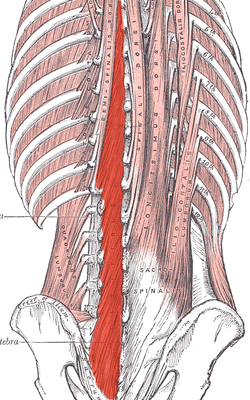| Multifidus muscle | |
|---|---|
| Deep muscles of the back. (Multifidus shaded in red.) | |
| Sacrum, dorsal surface. (Multifidus attachment outlined in red.) | |
| Latin | musculus multifidus |
| Gray's | subject #115 400 |
| Origin | Sacrum, Erector spinae Aponeurosis, PSIS, and Iliac crest |
| Insertion | spinous process |
| Artery | |
| Nerve | Posterior branches |
| Actions | Stabilizes vertebrae in local movements of vertebral column |
Deep in the spine, it spans three joint segments, and works to stabilize the joints at each segmental level.
The stiffness and stability makes each vertebra work more effectively, and reduces the degeneration of the joint structures.
These fasciculi arise:
- in the sacral region: from the back of the sacrum, as low as the fourth sacral foramen, from the aponeurosis of origin of the Sacrospinalis, from the medial surface of the posterior superior iliac spine, and from the posterior sacroiliac ligaments.
- in the lumbar region: from all the mamillary processes.
- in the thoracic region: from all the transverse processes.
- in the cervical region: from the articular processes of the lower four vertebrae.
These fasciculi vary in length: the most superficial, the longest, pass from one vertebra to the third or fourth above; those next in order run from one vertebra to the second or third above; while the deepest connect two contiguous vertebrae.
Multifidus lies deep to the Spinal Erectors, Transverse Abdominus, and Internal/External Obliques.
From Wikipedia, the free encyclopedia
http://www.back-in-business-physiotherapy.com/romePPT.php
http://www.exercisegoals.com/
http://www.weightrainer.net/
http://www.changingshape.com/exercise/strengthtraining/ http://www.lower-back-pain-toolkit.com/lower-back-pain-blog.html





No comments:
Post a Comment